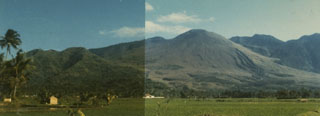Report on Guntur (Indonesia) — 8 May-14 May 2013
Smithsonian Institution / US Geological Survey
Weekly Volcanic Activity Report, 8 May-14 May 2013
Managing Editor: Sally Sennert.
Please cite this report as:
Global Volcanism Program, 2013. Report on Guntur (Indonesia) (Sennert, S, ed.). Weekly Volcanic Activity Report, 8 May-14 May 2013. Smithsonian Institution and US Geological Survey.
Guntur
Indonesia
7.143°S, 107.841°E; summit elev. 2251 m
All times are local (unless otherwise noted)
CVGHM reported that in early March a slight increase of deep and shallow volcanic-tectonic earthquakes at Guntur was recorded; volcanic tremor became continuous on 2 April, prompting CVGHM to raise the Alert Level to 2 (on a scale of 1-4).
Temperature measurements of hot springs in five different areas fluctuated until mid-April and then were relatively stable through early May. Seismicity also decreased in early May. On 7 May the Alert Level was lowered to 1.
Geological Summary. Guntur is a complex of several overlapping stratovolcanoes about 10 km NW of the city of Garut in western Java. Young lava flows, the most recent of which was erupted in 1840, are visible on the flanks of the erosionally unmodified Gunung Guntur, which rises about 1550 m above the plain of Garut. It is one of a group of younger cones constructed to the SW of an older eroded group of volcanoes at the NE end of the complex. Guntur, whose name means "thunder," is the only center with recorded activity, with eruptions since the late-17th century. Although it produced frequent explosive eruptions in the 19th century, it has not erupted since.
Source: Pusat Vulkanologi dan Mitigasi Bencana Geologi (PVMBG, also known as CVGHM)

